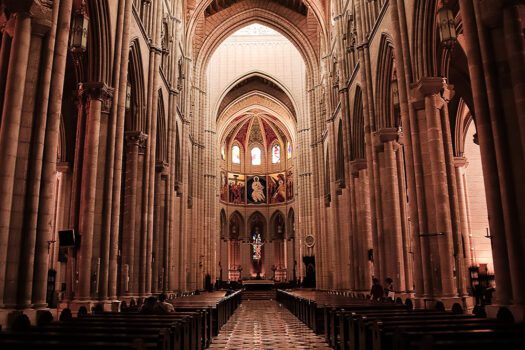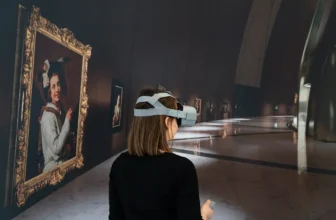Almudena Cathedral Madrid
A Symbol of Spain’s Faith, Resilience, and Modern Identity
In the heart of Spain’s vibrant capital stands an architectural marvel that merges history, faith, and cultural rebirth, the Almudena Cathedral, or in Spanish, Catedral de la Almudena. Just steps away from the Royal Palace of Madrid, this grand cathedral is not only a beacon of Roman Catholic devotion but also a visual narrative of Madrid’s evolution through the centuries. It is a spiritual monument, a historical relic, and an artistic triumph all rolled into one.
From its protracted construction saga that spanned over a century to its modern-day significance as a national symbol, Almudena Cathedral is more than just a church, it’s a testament to Madrid’s resilience and its unwavering Catholic heritage.
A Brief Overview: What Is the Catedral de la Almudena About?

Catedral de la almudena
The Catedral de la Almudena is the principal church of the Roman Catholic Archdiocese of Madrid. It is a relatively modern cathedral by European standards, having been completed and consecrated only in 1993 by Pope John Paul II. Despite its recent completion, the cathedral carries the weight of centuries of aspiration, political struggle, and religious devotion.
Named in honor of Our Lady of Almudena (Virgen de la Almudena), the patroness of Madrid, the cathedral was conceived as a grand religious edifice that would serve the growing capital’s faithful while standing toe-to-toe with other great cathedrals across Europe. Its location, directly facing the Royal Palace, symbolizes the deep-rooted connection between the Spanish monarchy and the Catholic Church.
Inside, the cathedral is a study in contrasts: neoclassical on the outside, neo-Gothic within, and richly adorned with contemporary religious art and stained glass. It is both a tribute to the past and a bold step into the future of sacred architecture.
The Long and Winding History of Almudena Cathedral
Though officially completed in 1993, the history of Almudena Cathedral is far older and more complex.
Origins in the 16th Century
The origins of the idea to build a major cathedral in Madrid date back to Philip II in the 16th century. When he made Madrid the capital of Spain in 1561, the city lacked a proper cathedral, an unusual oversight for a Catholic capital. However, construction never began, partly due to political instability, financial limitations, and the presence of nearby religious centers like the Toledo Cathedral, which remained the primate seat of Spain.
For centuries, Madrid’s spiritual needs were met by other churches, particularly San Isidro Church, which served as the city’s pro-cathedral.
The Resurrection of an Idea in the 19th Century
The modern initiative to build the cathedral began in earnest in the late 19th century. In 1868, the original Church of Santa María de la Almudena, an older medieval structure dedicated to the Virgin of Almudena, was demolished. Queen María de las Mercedes, the first wife of King Alfonso XII, had a strong devotion to the Virgin and championed the idea of building a new cathedral on the same site.
When the queen died tragically young in 1878, the king resolved to fulfill her dream. A Royal Decree in 1883 marked the official beginning of the project. Architect Francisco de Cubas, later the Marquis of Cubas, was appointed to oversee the construction. His original design was in the Gothic Revival style, influenced by French cathedrals.
Decades of Interrupted Progress
The first stone was laid in 1883, but construction was slow and fraught with problems. Political instability, including the Spanish Civil War (1936–1939), brought the project to a near halt. During the war, the partially built cathedral suffered damage and desecration.
After the war, Spain under Francisco Franco resumed the project, but progress remained sluggish. Over time, new architects were brought in, and the design underwent several revisions. Eventually, the façade was redesigned in neoclassical style to better match the Royal Palace it faces. This blend of styles is one of the most distinctive features of the cathedral today.
Completion and Consecration in 1993
After 110 years of planning and construction, the cathedral was finally completed and consecrated by Pope John Paul II on June 15, 1993. It was a landmark moment, the first and only time a pope has consecrated a cathedral in Spain.
Today, the cathedral is fully integrated into the cultural and religious life of Madrid. It is the seat of the Archdiocese of Madrid and hosts major liturgical events, including royal weddings, state funerals, and national celebrations.
Why Is Almudena Cathedral Famous?
There are several reasons why the Almudena Cathedral is famous and continues to attract millions of visitors each year.
1. Location and Symbolism
Situated across from the Royal Palace, the cathedral enjoys one of the most prominent locations in Madrid. Its placement not only makes it a visual anchor in the cityscape but also symbolizes the intertwined history of church and state in Spain.
2. Architectural Fusion
The cathedral is a rare example of a building that combines multiple architectural styles harmoniously:
Neoclassical exterior that complements the Royal Palace.
Neo-Gothic interior with soaring vaults and pointed arches.
Neo-Romanesque crypt, which houses tombs and is built in a more austere, early Christian style.
This unique mixture reflects the different historical periods during which the cathedral was built and remodeled.
3. Virgin of Almudena
The cathedral is home to the venerated statue of the Virgin of Almudena, an important religious figure for Madrid’s faithful. According to legend, the original statue was hidden inside the city walls during the Muslim occupation and rediscovered in the 11th century. This story adds a layer of mythic depth to the cathedral’s identity.
The Feast of the Virgin of Almudena, celebrated on November 9, draws large crowds and features processions, masses, and cultural events.
4. Papal Consecration
As the only cathedral in Spain to be consecrated by a pope, Almudena holds a special place in the Catholic world. The 1993 consecration by Pope John Paul II marked its full integration into the religious life of Spain and validated over a century of effort.
5. Royal Wedding Venue
The cathedral gained international attention in 2004, when it hosted the wedding of Prince Felipe (now King Felipe VI) and Letizia Ortiz Rocasolano, a journalist. The event was watched by millions around the world and marked a new chapter in the cathedral’s role as both a religious and state venue.
What’s Inside Almudena Cathedral?
The interior of Almudena Cathedral is bright, lofty, and surprisingly modern in its aesthetic. Unlike older European cathedrals steeped in centuries of wear and dark stone, Almudena feels fresh, spacious, and light-filled.
The nave rises nearly 100 feet, flanked by Gothic-style columns and arches.
Stained glass windows depict both traditional Biblical scenes and more contemporary Spanish religious imagery.
The altar is minimalist but majestic, surrounded by vibrant frescoes and mosaics.
The dome, painted with colorful, geometric designs, is a visual highlight.
Chapels throughout the cathedral are dedicated to various saints and feature modern interpretations of religious art.
The Crypt
One of the lesser-known but most fascinating parts of the cathedral is the crypt, accessible from the south side. Built in the Neo-Romanesque style, it houses over 400 columns, each with unique carved capitals, and contains several family tombs and the original statue of the Virgin of Almudena. The crypt feels like stepping back into the early days of Christianity and is often quieter than the main cathedral.
Is It Free to Enter Almudena Cathedral?
Yes, entry to Almudena Cathedral is free. Visitors can walk through the main nave, admire the architecture, and even attend Mass without paying an entrance fee.
However, there are some optional areas that require a small donation or entrance fee:
Museum and Dome Access: For around €7, visitors can enter the Cathedral Museum, which contains religious artifacts, vestments, and historical displays about the construction and significance of the cathedral. The fee also includes access to the dome, offering panoramic views of Madrid and the Royal Palace.
Crypt: Entry to the crypt is often free, though donations are encouraged. Some guided tours include it as part of a package.
It’s advisable to check the official website or local signage for the most current pricing and opening hours.
Visiting Almudena Cathedral: Tips and Highlights
Location: Calle de Bailén, 10, Madrid. Right next to the Royal Palace.
Opening Hours: Generally open from 10:00 AM to 8:30 PM, with some variation on religious holidays.
Best Time to Visit: Early morning or late afternoon for smaller crowds and better lighting.
Dress Code: As a functioning place of worship, modest attire is appreciated, no tank tops or short shorts.
Photography: Allowed in most areas, but flash photography and tripods may be restricted.
A Living Testament to Madrid’s Soul
Almudena Cathedral is not just another pretty church in Europe, it is a living monument to Madrid’s soul. It embodies the hopes of kings and queens, the faith of generations, and the persistence of a city that never gave up on its spiritual dream. Its long, interrupted journey to completion mirrors Spain’s own tumultuous path through monarchy, republic, dictatorship, and democracy.
Whether you are a pilgrim, a history enthusiast, or a casual traveler, the Almudena Cathedral offers a profound encounter with Spain’s past and present. It is a space where silence speaks volumes, stone and glass tell stories, and every arch and vault draws your eyes upward, toward heaven, yes, but also toward the enduring spirit of Madrid.




